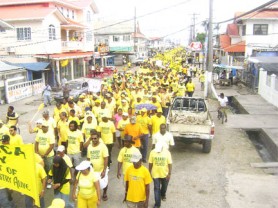Demonstration driven by fear of official moves to reduce small-scale mining activity
Bartica this week handed the government of President Bharrat Jagdeo the first major non-political mass protest of its tenure as the community known as the gateway to the country’s mineral-rich interior shut itself down and took to the streets in a massive demonstration against new mining regulations which it fears will cripple much of the small and medium scale gold mining activity upon which the township depends for its economic existence.
The protest, which brought together miners and ordinary residents of Bartica and neighbouring communities including, significantly, Amerindian communities that rely heavily on the mining sector, directly and indirectly, for a living, brought thousands of yellow-clad demonstrators onto the streets, making good their promise to bring the community to a standstill.
The Bartica protest marked an uncharacteristic confrontation between government and the private sector, signalling a posture of militancy among miners not usually demonstrated in the country’s conservative business community; and while Prime Minister Samuel Hinds asserted during a Monday evening NCN television interview that opposition political influence had manifested itself in the protest, the leaders of the protest, all miners and their representatives, insisted that their quarrel with government was specifically over new regulations that require small and medium scale miners to give the authorities six months notice of their intention to start new mining operations and to conduct prior prospecting activities.
While government has gone to considerable lengths to seek to assure the miners that the new regulations are designed to do no more than bring a greater sense of order to a mining sector in which there is much evidence of environmental lawlessness, the Bartica protest linked the appearance of the new regulations to government’s declared intention to assume a more robust posture on environmental issues in the wake of the promulgation of President Jagdeo’s Low Carbon Development Strategy (LCDS) and the recent signing of an agreement with the Government of Norway which holds the administration to higher environmental standards.
Government has been keen to demonstrate that the LCDS has the backing of the mining sector and Amerindian communities in sections of the country’s forested areas, though the Bartica protest took aim at what they regard as a link between government’s aggressive promulgation of the LCDS and measures to tighten existing mining regulations and put new ones in place.
Weeks before last Monday’s protest, the hidden hand of a financially able and seemingly determined mining lobby appeared to be behind the publication of advertisements in the print media challenging what miners believe is an exaggeration of official claims that the industry is guilty of widespread environmental recklessness. Last week’s five-page newspaper advertisement headed Climate Change Is Not Man Made – probably a record number of newspaper pages for a single private sector advertisement – openly challenged official assertions that the mining industry as a whole presents a mortal danger to the environment. While the ad concedes that “a few miners act indiscriminately” it asserts that blame for reckless mining practices cannot be placed at the door of the entire industry.
If government’s concerns over environmental degradation resulting from reckless mining practices is well-founded, the Guyana Gold and Diamond Miners Association (GGDMA) Executive Director Edward Shields argues the guilt is shared by a minority of miners and that the persistence of those practices is largely a function of the inability of the Guyana Geology and Mines Commission (GGMC) to implement an effective regimen for the sanctioning of transgressors. Several miners, while not denying the existence of instances of environmental lawlessness in the sector have said that the persistence of disregard for the environment is due in some measure to corrupt practices that often manifest themselves in the selective application of official sanctions in cases where transgressions were discovered. In a recent interview with this newspaper Shields said that the position of the GGDMA was that what was needed was the effective enforcement of existing mining regulations rather than the application of new ones. He said too that the GGMC’s policing limitations were due in large measure to its inability to deploy enough mining officers to cover all of the scattered mining communities.
For the moment at least, the mining sector, part of a customarily compliant private sector, appears decidedly disinclined to back away from what it says are tough new measures being imposed by the state which it says could strangle hundreds of small scale miners who produce the vast majority of the country’s total gold yield. In an uncharacteristically blunt assessment of the significance of the new regulations Shields said that be believes that they amount to “an exit strategy” for small scale miners, a thinly veiled suggestion that the new regulations could force hundreds of small and medium scale miners out of business.
As talk of a possible shutdown of Bartica gathered momentum last week government dispatched a ministerial team to the township that included then acting Prime Minister Robert Persaud Hydraulics and Transport Minister Robeson Benn. Both Ministers focused their interaction with the miners on the miners’ publicly expressed fears that the new regulations were indeed intended to reduce the level of mining activity and, by extension, the extent of environmental degradation in the country’s forested areas to attempt to forestall the protest action. Persaud alluded to the recent establishment by President Jagdeo of a Land Use Committee which he said could be used as a forum for discussing the miners’ concerns and even alluded to the possibility than some miners may be exempted from the six-month notice regulation.
Nothing that the Ministers said, however, appeared to affect the militant mood of the miners and amidst the highly-charged environment of last Monday’s huge protest Shields restated his “exit strategy” concern while other miners who addressed the rally publicly declared that nothing short of an encounter with the President himself would satisfy them.
For its part and despite the unmistakable show of public support for the Bartica protest, the government gave no indication that it was inclined to back away. Even as the Monday Bartica demonstration was winding down Prime Minister Hinds, who is responsible to cabinet for the mining sector, was using his television interview to mount a spirited defence of government’s proposed six months prior notice regulation.
Last weekend, in what may yet turn out to be a significant development, the two umbrella organizations representing the mining and forestry sectors issued a joint statement asserting that “equal opportunities should be given to both sectors for development” and that “there is no real land use conflict (perceived or otherwise) between legal miners and the loggers.” The statement appeared to be a hurried attempt by the two sectors to bury known differences between them over where blame should be placed for environmental destruction in the interior. During his interview with the Stabroek Business Shields had made it clear that the miners’ opposition to the contemplated granting of a prerogative to the Guyana Forestry Commission (GFC) to append its recommendation to applications for new mining permits was “non negotiable.”
Government has continually expressed concern over practices in both the forestry and mining sectors which it says shows scant regard for the environment. Rising gold prices in recent years have led to charges of what the Prime Minister described some months ago as a “gold rush” which he said had been attended by a considerable measure of reckless mining practices. The two sectors, mining and forestry, have sometimes indulged in a blame game with the forestry sector charging that while regulations governing the harvesting of timber set out stringent and specific guidelines, the absence of similar restrictions in the mining sector has resulted in widespread indiscriminate felling of trees by some miners in what they believe to be gold-bearing areas. Shields vigorously refutes these claims. During his interview with Stabroek Business he specifically challenged claims which he says were made by the forestry sector that in 2007 miners felled a total of 24,000 hectares of trees pointing to the GGMC’s figure of 4,000 hectares the following year and contending that the difference in years notwithstanding, the six-fold difference in the two figures raises questions about the accuracy of the forestry sector’s claims.
Last weekend, in a somewhat surprising development, the mining and forestry sectors appeared to find common cause, issuing a joint statement to the effect that there was room for both sectors in the country’s forests. Shields had earlier pointed to the possibility of continued strained relations between the two sectors in the wake of another promised new procedure that gives the Guyana Forestry Commission the prerogative of reviewing applications for mining claims ahead of the granting of official approval by the GGMC. Shields had told Stabroek Business that the miners’ opposition to any regulation that gave the forestry sector that kind of say in the mining sector was “non negotiable.”
The current impasse between the state and the mostly small and medium scale operators in the mining sector comes on the heels of the industry’s declaration of gold production in excess of 300,000 tons that netted more than $US300m in earnings. In his interview with this newspaper Shields had pointed out that the performance of the mining sector last year had had the effect of generating higher levels of investment in the sector. He said that in the absence of commercial bank lending, small and medium scale investors in the sector had made other loan arrangements amounting to millions of dollars and that the application of new regulations including the requirement of prior prospecting by small and medium scale miners would result in a huge loss of investments in the sector.



